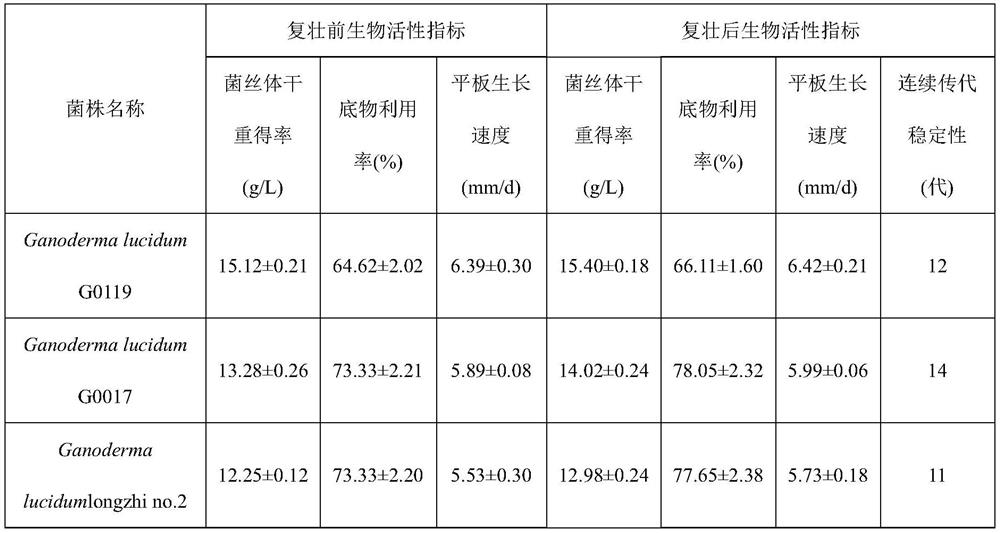Rejuvenation method of special ganoderma lucidum strain for liquid fermentation
A technology of liquid fermentation and Ganoderma lucidum mycelium, applied in microorganism-based methods, biochemical equipment and methods, fungi, etc., can solve the problems of easy degradation, aging, and unstable Ganoderma lucidum strains, so as to reduce the pollution rate, The effect of solving the degradation of bacteria and improving the yield of mycelium
- Summary
- Abstract
- Description
- Claims
- Application Information
AI Technical Summary
Problems solved by technology
Method used
Image
Examples
Embodiment 1
[0050] Parent Ganoderma lucidum strain: Ganoderma lucidum G0119 (provided and preserved by the Institute of Edible Fungi, Shanghai Academy of Agricultural Sciences, preservation number: HunongLingzhi No.1), which has been published in [Biotechnology and BioprocessEngineering 2014 Volume 19 Issue 4 727-732].
[0051] The Ganoderma lucidum strain after rejuvenation by this method, as shown in table 1 result, before rejuvenation, mycelia dry weight yield (15.12 ± 0.21) g / L, substrate utilization rate (64.62 ± 2.02)%, plate growth rate (6.39 ±0.30) mm / d, mycelium dry weight yield after rejuvenation (15.40±0.18) g / L, substrate utilization rate (66.11±1.60)%, plate growth rate (6.42±0.21) mm / d. The mycelium yield and substrate glucose utilization rate were stable before and after rejuvenation, and the fluctuation range of 12 consecutive passages was less than 8%.
Embodiment 2
[0053] Parent Ganoderma lucidum strain: G.lucidum G0017 (provided and preserved by the Institute of Edible Fungi, Shanghai Academy of Agricultural Sciences, preservation number: G.lucidum G0017), has been published in [International Journal of Medicinal Mushrooms 2021 Volume 23 Issue 3 Issue 43-53] public.
[0054] The Ganoderma lucidum strain rejuvenated by this method, as shown in table 1 result, mycelia dry weight yield (13.28 ± 0.26) g / L before rejuvenation, substrate utilization rate (73.33 ± 2.21) %, plate growth rate (5.89 ± 0.26) g / L 0.08) mm / d, mycelium dry weight yield after rejuvenation (14.02±0.24) g / L, substrate utilization rate (78.05±2.32)%, plate growth rate (5.99±0.06) mm / d. The mycelium yield and substrate glucose utilization rate were stable before and after rejuvenation, and the fluctuation range of 14 consecutive passages was less than 9%.
Embodiment 3
[0056]Parental Ganoderma lucidum strain: G.lucidum (provided and preserved by the Institute of Edible Fungi, Shanghai Academy of Agricultural Sciences, preservation number longzhi no.2), which has been published in [Journal of Edible Fungi, Vol. 27, No. 2, 2020, 84-91].
[0057] The Ganoderma lucidum strain rejuvenated by this method, as shown in table 1 result, mycelia dry weight yield (12.25 ± 0.12) g / L before rejuvenation, substrate utilization rate (73.33 ± 2.2) %, plate growth rate (5.53 ± 0.12) g / L 0.30) mm / d, mycelium dry weight yield after rejuvenation (12.98±0.24) g / L, substrate utilization rate (77.65±2.38)%, plate growth rate (5.73±0.18) mm / d. Before and after rejuvenation, mycelium yield and substrate glucose utilization were stable, and the fluctuation range of 11 consecutive passages was less than 7%.
[0058] In Examples 1-3, the comparison of the biological activity indexes before and after the rejuvenation of the ganoderma lucidum strain is shown in the follow...
PUM
 Login to View More
Login to View More Abstract
Description
Claims
Application Information
 Login to View More
Login to View More - R&D
- Intellectual Property
- Life Sciences
- Materials
- Tech Scout
- Unparalleled Data Quality
- Higher Quality Content
- 60% Fewer Hallucinations
Browse by: Latest US Patents, China's latest patents, Technical Efficacy Thesaurus, Application Domain, Technology Topic, Popular Technical Reports.
© 2025 PatSnap. All rights reserved.Legal|Privacy policy|Modern Slavery Act Transparency Statement|Sitemap|About US| Contact US: help@patsnap.com

